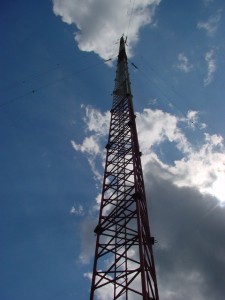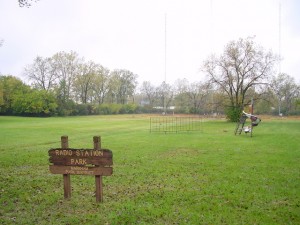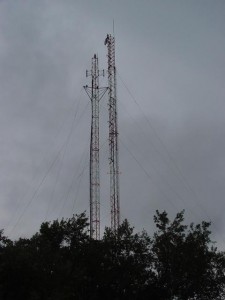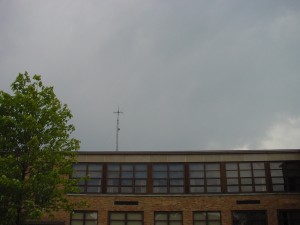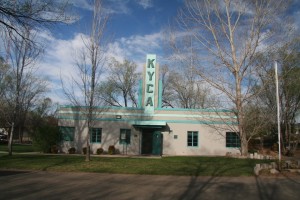Fandom is an amazing thing and thanks to the Internet it’s easier and easier to find like-minded obsessives who share one’s passion for the most obscure objects, idols, and idiosyncrasies. Radio is no exception. Loads of websites document radio history, with nostalgic archivists collecting ephemera, airchecks, and reminiscences from San Francisco to Boston. Various forums also exist, like those on Radio-Info.com, allowing listeners and industry types to talk shop and share current radio gossip.
And then there’s Garrett Wollman. I recently ran across some of his photographs of radio towers and was fascinated. As part of his work with The Archives @ BostonRadio.org, he’s been traveling around the country meticulously photographing every radio tower that he can find. Sometimes he even ventures into radio and television stations; but for the most part it’s the outside architecture and landscapes that he finds so compelling.
In order to learn more about this project, I contacted Garrett to get the scoop about his love for radio towers and his work to help document the history of radio and television. I was surprised to find out a couple of things: 1) Garrett’s a young guy—a rarity in radio history circles and 2) He’s not a big fan of current radio offerings. After chatting with Garrett, I also was made aware of pursuits like DXing and county counting, making me realize that there’s so much more to the radio scene than I ever realized. On to the interview:
Jennifer: Can you tell me about the background and purpose of BostonRadio.org? And the Archives?
Garrett Wollman: The Archives @ BostonRadio.org (originally The Boston Radio Archives) is, so far as I know, the oldest broadcasting-history Web site on the net. Scott [Fybush] and I started it in January, 1995, with a simple listing of information about the stations in the Boston market…Scott was already writing his New England RadioWatcher columns (now NorthEast Radio Watch)…and I started to archive them. I also started creating radio and TV dial pages for other markets in New England, and I think around that same time we started writing histories of all the stations…Eventually, the dial pages became too hard to maintain, and other Web sites (like Chip Kelley’s original 100000watts) were doing it better, so I dropped them, but kept the histories.
My first tower-hunting trip was to Cape Cod, in March, 1994. A couple years later — this is still before the days of good digital cameras– I started taking video of the tower trips. Eventually, digital cameras became good enough, and I bought on in late 2000; that’s when I started developing the photo galleries that you see in the Archives. What you see is, by the way, less than half of what I actually have “in the can” — I have several thousand more photos from 2001 through last month that I have not yet published.
Each photo gallery involves about 20 hours of work to write and edit, even though the images you see are rarely processed in any meaningful way. Often, when doing a photo gallery about a market, I will do research in the FCC files, in other reference books like /Broadcasting Yearbook/, and in Web resources like mailing-list archives and Wikipedia, to fill in as much as I can about the history of a facility.
I try to identify the correct callsign, community of license, channel, and station class (FM) or antenna mode (AM) for each station at the specific time the photos were taken. I want to get more semantic tagging into the photo galleries, so that it would be easier to identify, for example, all the photos (across multiple galleries) of a particular station or tower, but thus far this has been stymied by my rather antiquated, homebrew workflow.
Garrett: Well, I’m not sure that I am. I’m really passionate about geography, history, and some aspects of architecture, and touring the world’s broadcast sites unites a lot of those interests. I find much of today’s radio unlistenable and television unwatchable.
On the other hand, I grew up in the 1980s — during the second round of CHR [Contemporary Hits Radio] Wars — at a time when radio still meant something to a lot of people. It still mattered, when I was going school, what station you listened to; those of my classmates who listened to Q-99 or B-100 were looked down upon by the 95 Triple X crowd, and those of us who listened to Triple X were considered hopelessly bereft of taste by the rock snobs who listened to The Wizard.
By the early 1990s, CHR formats had left me behind (at the ripe old age of 20!), and when I moved to Boston I eventually gravitated to AAA…I learned to listen to — if not always like — some great evening talk hosts, like the late Dr. David Brudnoy on WBZ, and I still enjoy (but don’t listen very much) to the meandering, but usually non-political, Steve LeVeille on WBZ overnights. Most of my listening today is to the BBC (both World Service, heard here on WBUR, and domestic Radio 4 over the Internet), and in the car to WXRV (92.5B Haverhill), WBZ, and the XM decades channels (particularly 80s on 8 and 90s on 9).
On the gripping hand, I have an engineering (specifically computer networking) background, so I have both an appreciation for the behind-the-scenes work that engineers of all kinds do, and the sort of curiosity that makes me want to know how stuff works, and why, and who built it, and where does it come from. When I’m not doing this stuff, you’ll find me reading planning documents about a local highway project, or writing a Wikipedia article about a recent Supreme Court decision.
I seem to be running out of limbs here…One final factor is that my parents absolutely refused to pay extra for an FM radio in their cars when I was growing up. For much of that period, we lived well east of Burlington, Vermont, and thus well out of the night patterns of the AM stations there. In the winter months, as my father was driving my home from a Scout meeting or other evening event, I would tune the radio and listen to all the other things on the radio — and back then, the AM dial wasn’t filled with satellite talk at night — so we might hear something completely different from anything available locally.
I particularly remember hearing Wolfman Jack on W****N****BC on these late nights. So I became, unintentionally, something of a DXer as well, and that fed into the geography interest, at least until the AM dial became so filled with indistinguishable satellite junk that there was no longer much interest left. I joined some of the DX clubs, but eventually dropped out when it seemed that they were mostly interested in yammering on forever about how much better it was in the decades before I was born. (I’m still a member of the Worldwide TV-FM DX Association, which is a bit less prone to this sort of nostalgic excess.)
Garrett: Never.
Jennifer: How many towers have you photographed? What states have you visited?
Garrett: I have visited all of the lower 48 except North Dakota, New Mexico, Oklahoma, Arkansas, and Mississippi. I will fix all of these at some point. (A friend of mine, George Greene, is a county-counter, so he has actually visited every single *county* — a much more difficult challenge.) I’ve done five Canadian provinces, all in the east.
On my current camera, I’ve taken about 10,000 shots. I think I was somewhere close to 3,000 on the old camera. (What a difference bigger memory makes!) Of course, many of those pictures are junk, and will never be seen on the Web site. But given all that, I believe I’ve seen in excess of 3,000 stations, and photographed over two thirds of them.
Garrett: Touring radio stations is something that’s normally arranged by my partner-in-crime, Scott Fybush. As a freelance journalist in the trade press, he goes to trade shows and meetings of industry organizations, and knows a lot of people who can open the doors for us at various station groups. It can be a lot easier to get a tour when you can start your conversation with “I spoke to [name of CEO] at NAB last year, and he said I really ought to see your stations.” I can’t do that — it’s strictly a hobby for me — so when I travel alone it’s mostly the outsides of things that I see, unless it’s a business day in a small market and I can just walk in the front door and get an impromptu tour. (Such things do happen!)
We do try to make maps that show where all the studios and transmitters are, also noting any particularly significant historic studio locations. Currently this is all on paper; some day soon, GPS systems will be good enough to assist us in the navigation, although I will probably still want paper maps for my own reference after the fact. (I’ve been able to piece together photo galleries from seven-year-old photos because I still had the maps and could figure out what route we had taken through a market.)
Jennifer: Have you visited any college radio stations? If so, which ones?
Garrett: I’ve seen a good number of college stations from the outside. As far as inside tours go — and excluding college-owned public radio — I’ve seen WBRU (95.5B Providence) and WREK (91.1C2 Atlanta) this year. In the past, I’ve seen WHRB (95.3A Cambridge), WMBR (88.1A Cambridge), and a few others that I can’t readily remember.
Garrett: There was the time, back during “Big Trip 2001“, when we were in Floyd’s Knobs, Indiana — across the river from Louisville — and an elderly local accosted us and insisted that we were government agents who had some control over the radiation in his neighborhood.
There was also one time — I forget which year this was — when we went to see the tower of WHPE-FM (95.5C1 High Point), and had the security manager of the chemical plant across the street call us in to the police as suspicious characters. Thankfully, the rental car was not in my name that trip….
Garrett: Yes and no. As a medium, absolutely. There will always be a place for a medium of information and entertainment that does not demand all of our attention at once. There’s no substitute for radio when driving or doing any number of other, primarily visual tasks.
As a means of delivering prerecorded music, not so much. Radio programmers and record companies have so segmented the market that there is no longer a mass audience for musical entertainment any more. The days when a CHR could pull a 25 share are gone, in every market. With dozens of choices on the radio today, none of which are precisely what I want, why would I set through the endless commercials (or endless fundraisers) when I can get exactly what I want from Pandora or my iPod?
The specific technologies of over-the-air broadcasting are clearly on their last legs in the developed world — I give them another decade, maybe two if the broadcasting industry succeeds in its drive to put non-broadcast radio at a competitive disadvantage (through, e.g., the “Local Radio Freedom Act”, which preserves in law the subsidy regime whereby analog broadcasters can use recorded music for free, but digital broadcasters have to pay). In the developing world, probably about twice as long, because the economics of broadcast are much more favorable there (traditional analog receivers are small, light, cheap, and battery-powered, whereas transmitters are big, heavy, expensive, and require an external power source).
All this, of course, is reason to go and see these facilities while they are still around. I almost certainly won’t get to all 14,000 — and some of them really aren’t worth getting to — but I am making an effort to see all the significant sites in all the significant markets while they are still with us.
Garrett: I like non-comm AAA and Americana formats, particularly WXPN (88.5 Philadelphia) and WNCW (88.7 Spindale) of five to ten years ago. I think a lot of the NPR news and talk programming is excellent, but it honestly doesn’t do anything for me. The best spoken-word radio station in the English-speaking world, in my view, is BBC Radio 4 — it’s everything that I wish NPR was but could never be. (What other English language radio station is still commissioning new drama?) If this were Britain, that would be making a pretty strong statement of my social class, but thankfully it isn’t, and they provide “Listen Again” worldwide for most shows, so I can get my fix of “I’m Sorry I Haven’t a Clue” or “The News Quiz” or even the Shipping Forecast at a time that fits my leftpondian schedule.
Most of today’s music formats turn me off. If I’m stuck in a market where there’s nothing else to listen to, I may find a local Hot AC or Modern Rocker, but I’m just as likely to turn the radio off.
Garrett: Rarely. There are plenty of college stations around Boston, and some of them even do worthwhile programming at least occasionally, but they’re never dependable enough, and there are lots of other choices here in market #11. Some of the smaller college stations, and most of the high school stations, show little evidence of understanding what operating a radio station is about; if they have any listeners who aren’t actually in the studio, it would be a surprise. Many of them seem to look at it as a glorified iPod, and put little or no effort into presentation. But there are occasional gems.
I remember about 18 months ago, on the little class-D high-school station in Acton, Mass., hearing a student on the air who actually seemed to have some idea of what a jock is supposed to do; I actually sent him an email complimenting him on his presentation and suggesting that he look for colleges that have a student-run station. (Of course, he then spoiled the impression by dumping carrier without a legal ID when his shift was over — stations with limited schedules like that really ought to get hooked up with a radio reading service.)

